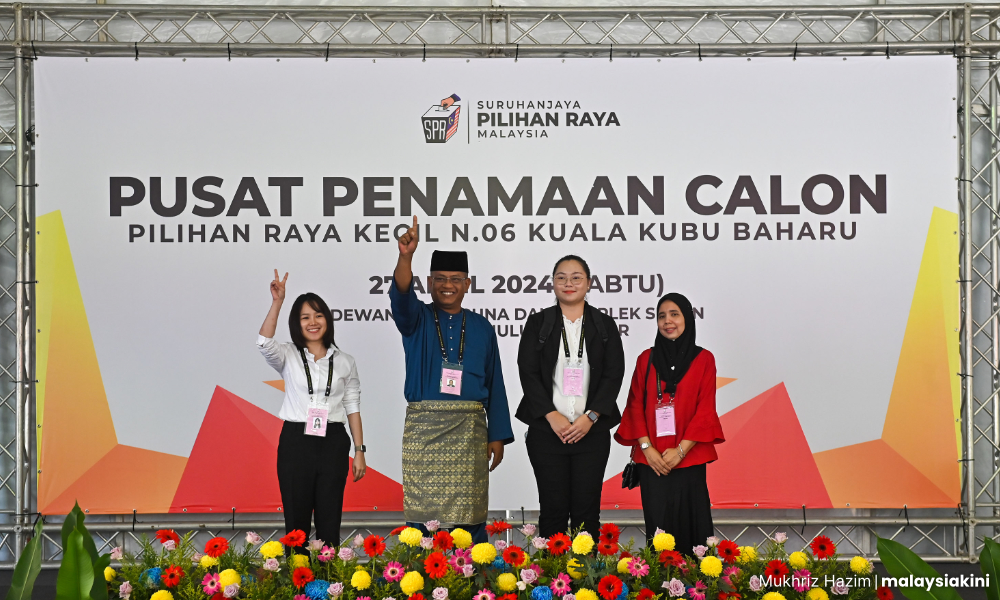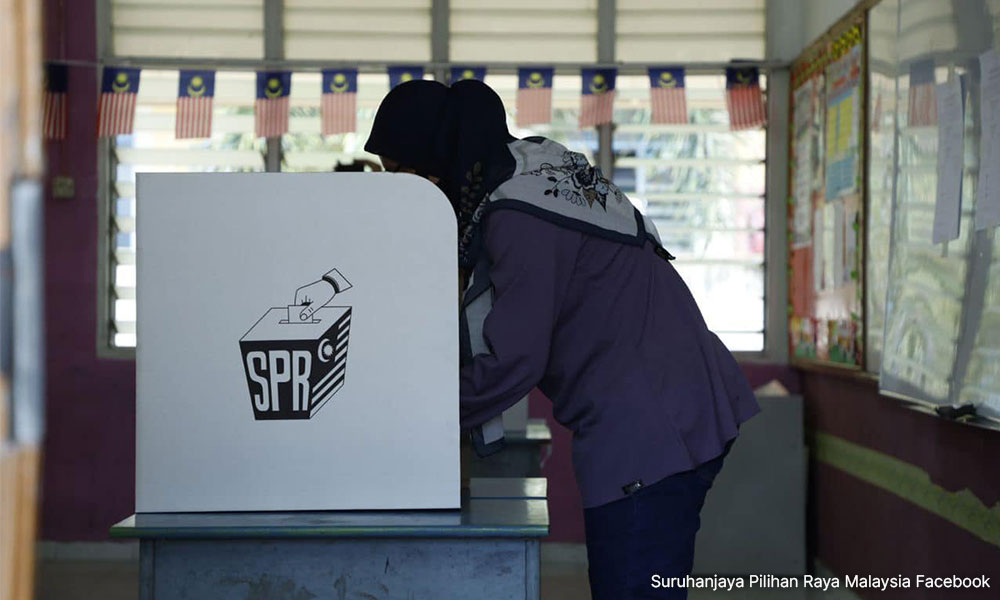Over the past few weeks, the main question about Kuala Kubu Bharu has been who will win. Given the reality of ongoing fluid changes in voter sentiments and the importance of campaigns in Malaysia, especially in close contests, it is still too early in the campaign to make a confident prediction.
Previous voting patterns do provide insights. So far, the dominant lens to understand voting by political parties has been to focus on ethnic patterns of turnout and support. This piece goes further, bringing in multiple lenses to understand voting.
I argue that the overlooked category of class voting, measured by average incomes in different localities, provides considerable additional insight into recent changes in voting patterns, as does attention to generation voting.
Unfortunately, statistically, the data does not provide enough robustness to measure voter differences by gender due to limited data points for variation.
Kuala Kubu Baharu is a diverse constituency, not just in its ethnic composition (46 percent Malay, 31 percent Chinese, 18 percent Indian and five percent others) but also in that it incorporates varied urban, semi and rural areas. Some parts of the constituency have been seriously neglected in development, while simultaneously the state government has made significant improvements in connectivity and welfare, especially in the town.
This piece looks at voting trends using estimates from localised polling station data. The focus of the analysis is on the last two elections in Kuala Kubu Baharu - GE15 in 2022 and the state elections last year.
The findings confirm that of others, the trajectory has been one of declining support for the incumbent party, the DAP, shifts in support toward Perikatan Nasional as well as ethnic polarisation in voting and interesting shifts along generation and class lines.
Both sides - Pakatan Harapan and PN - have honed their candidate and campaign strategies after looking at their analyses of voting trends, with Perikatan Nasional strategically opting for a Malay local candidate hoping to strengthen its electoral support.

DAP on its part has chosen to stick with its traditional pattern in the seat, fielding a dynamic, young, female candidate with strong ties to the party as opposed to the constituency. Voting trends suggest that both major party contenders will have their work cut out for them to win the seat.
Decline In turnout: Poorest voters disengaging
Voter turnout in Kuala Kubu Baharu has been declining. This trajectory is in line with national trends, but the scope of the decline is slightly higher. Overall voter turnout dropped from 88 percent in 2018 to 77 percent in 2022 and 69 percent in 2023. Turnout in Selangor was slightly higher at 72 percent.
The analysis of localities shows that the most decisive shift in turnout was among voters living in poorer areas, who disproportionately did not vote in the state elections compared to GE15, by an estimated drop of a whopping 43 percent.
This trend cuts across communities. The state election campaign relied less on vote buying than the general election and there was less outreach and mobilisation in areas where voters were socioeconomically disadvantaged. They were and are being left behind.
Class was arguably one of the most important features explaining voting in Kuala Kubu Baharu, a point developed below. Poorer voters did not feel that any of the political alternatives would improve their lives.
Other explanatory lenses for the turnout drop were evident as well. The estimates of voter turnout in Kuala Kubu Baharu by ethnicity and generation suggest turnout decline has been concentrated among Malays, Indians, and younger voters under 30.

In the state elections, Indians had the lowest estimated turnout of only 53 percent, already pointing to dissatisfaction in this community with the Anwar Ibrahim government’s poor treatment and exclusion of this community.
Many of the Indians in Kuala Kubu Baharu are facing dire socioeconomic conditions that are being ignored. It remains to see whether this trend will drop further, which has been an aim of critics drawing attention to both the national and state governments’ failures to promote genuinely inclusive policies and that Anwar’s unity government takes Indians for granted.
Malay turnout dropped as well by an estimated nine percent, as, here too, there was dissatisfaction with the options on offer. PN hopes to reverse this trend.
The turnout of voters under 40 also declined, with many not coming home to vote, especially those under 30. DAP’s fielding of a young candidate hopes to reverse this trend.

The issues to watch in this by-election are not only reversals but also whether new trends will emerge with a potential decline in Chinese turnout which could impact DAP’s result.
The findings from estimates of turnout among core supporters for different parties show that DAP has minimised turnout drops compared to other parties.
Considerably more BN and PN supporters opted not to vote in the state election, in part perhaps due to the seat seen as being secure for incumbent DAP and the limited appeal of the major candidates connecting to Malays.
PN’s ability to address this will shape the outcome, especially if Bersatu is able to attract previous BN-aligned voters who opted to stay home.

Ethnic polarisation and maximisation
A look at ethnic voting in Kuala Kubu Baharu in the last two polls shows both consistency and variation. Among the two largest groups - Malays and Chinese - vote patterns remain polarised. Chinese voters remained extremely loyal to Harapan, voting over 90 percent for the DAP.
In fact, Harapan's cooperation with BN in the state elections led to no major gains among either the Chinese or Malay communities. The ethnic polarisation of the vote increased in the state election, with Indian voters (traditionally with BN due to MIC having a historic base of support in this area of Hulu Selangor) moving to the unity government by a margin of an estimated 14 percent. Many other Indians, as noted above, stayed home.
Among Malay voters, the move toward PN was clear, with an estimated 17 percent swing, the overwhelming majority who previously voted for BN. For PN, the issue is whether they can win over even greater Malay support, while for DAP the issue is whether they will retain PRN2023 support levels among all of the groups.

PN may have reached the maximum Malay support in the 2023 state elections and has yet to garner any support among Chinese or Indian voters in KKB. DAP on its part may also have maximised its support among communities and may face diminishing support.
Importantly, all of the ethnic groups are important in this close contest and even small swings in either turnout or support across any one community could change the outcome.
Age voting: PN youth gains
A look at voting by age suggests that PN continues winning among younger voters under 30, reaching an estimated 49 percent in the state elections.
Harapan working with BN, however, won an estimated 45 percent of this age cohort, and the majority of all the other cohorts, especially older voters.
The age cohort that will be particularly interesting to watch are voters in their 30s who witnessed the most movement toward PN in the last state election and are a dynamic cohort of voters.
Beyond fielding a young candidate, none of the campaigns have programs geared toward younger voters.

Saliency of class voting
As with the swing in turnout, class was also the factor that was associated with swings in support in recent elections in Kuala Kubu Baharu.
While gains were made across socioeconomic categories, PN managed to win over an estimated quarter (25 percent) of support from voters living in the poorest areas. Most of these poorest voters had voted for BN in the past.
The saliency of class issues in Kuala Kubu Baharu is evident with both Muda and Parti Rakyat Malaysia’s Chang Boon Lia (disqualified for this by-election due to failing to file his expenses) winning an estimated 19 percent of this group.

It is also important not to overinterpret these results. While they were significant in shaping outcomes, do note that percentages are higher as the number of voters in these poorest areas with household incomes less than RM3,000 is comparatively smaller than those with higher incomes.
The Kuala Kubu Baharu findings show, however, that livelihoods and socio-economic conditions matter in Malaysian campaigns, especially in constituencies with neglect and uneven development.

Some takeaways
Given the diverse voting patterns, what lessons can be drawn for any potential victory in KKB?
It is evident that turnout will matter, but what will be important for the result is among which ethnic community and age cohort.
No one ethnic community is more important in shaping the outcome than any other. For PN to win (and DAP to lose), it will need either a large swing among Malays (which is difficult as support may have reached its maximum in the 2023 state elections) or multiple shifts in voting among other ethnic communities. It will be difficult for PN to win from changes in Malay support alone.
Changes in voting are more common among younger voters under 40. This is an important cohort to watch in shaping the result.
Class matters and Kuala Kubu Baharu voting shows many with needs being excluded and disengaging as parties seem more concerned with winning rather than service.

Given that the outcome is the result of multiple social factors in a tight contest, not just ethnicity, the campaign – its narratives and mobilisation will be critical.
This will be the next piece in the series closer to the end of the campaign when patterns on the ground become more evident.
Irrespective of what lies ahead for the result, an analysis of voting in Kuala Kubu Baharu provides a lens to show that political engagement cannot be one-dimensional.
The burden is on political parties to provide more, especially to go beyond ethnic rhetoric and mobilisation and provide concrete deliverables for a constituency that deserves more than it has received in recent years. - Mkini
BRIDGET WELSH is an honourary research associate of the University of Nottingham’s Asia Research Institute, a senior research associate at Hu Fu Center for East Asia Democratic Studies, and a senior associate fellow at The Habibie Centre. Her writings can be found at bridgetwelsh.com.
The views expressed here are those of the author/contributor and do not necessarily represent the views of MMKtT.



No comments:
Post a Comment
Note: Only a member of this blog may post a comment.